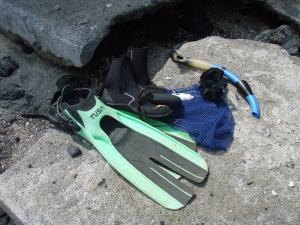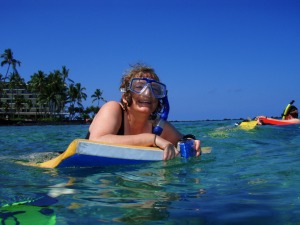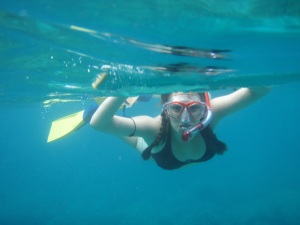By Donnie MacGowan

Coming to my island for a vacation? There are three things I always recommend the first-time visitor do. First, get in the air--seeing my island from the air is the only way to appreciate its vastness and diversity of landscapes-and it's the best way to see the erupting volcano.
Secondly-go to a luau--for people with limited time, you will not be able to discover much about the magic of the local lifestyle, and although canned and packaged for visitor consumption, a luau is a good place to get an introduction to it.
Finally, I advise people of every age to get in the water and go snorkeling. The "one-one-one, experiencing the world through the fishes' eyes" magic of swimming in those bath-warm lagoons surrounded by clouds of tropical fish is an amazing, restful and restorative pursuit-you will find your mind going back to that experience over and over through the years much more so than many of your other travel experiences. There are some things to bear in mind about snorkeling, however, so let's take a moment to talk about gear (covered here, in Part I), technique (covered in our next post, Part II), reef etiquette and the animals which inhabit the coral reefs (which will be in Part III) and safety (coming in Part IV).
First some advice about snorkeling gear:
Bringing vs. Renting vs. Buying: Bringing your personal snorkeling gear from home insures that you are familiar with the gear and you know that it fits…but it's a hassle in your luggage. In this day and age of paying for extra baggage, it may be better to simply rent. Renting gear once you get to your destination is cheaper than buying it there and you don't have to make room in your luggage to lug it home.
Fit: The mask should fit snugly over the face; you should be able to hold it onto your face with suction simply by taking in a quick breath through your nose. The strap should be snug enough to hold the mask in place against face but it should not be tight--if it is too tight, it'll make wrinkles in the seal, letting water in. Simple water pressure against the outside of the mask seals it. If you wear glasses, either use contacts while snorkeling or get a mask that has vision-corrected mask lenses (which is more expensive, but almost universally available); it's almost never possible to seal a mask around your glasses.
Fins should fit snugly like shoes, but you should able to pull them on and off without a struggle. If they are too loose, you'll either lose them or get blisters; if they are too tight, you'll get cramps AND blisters. With fins you need to make a choice. Shoe-style fins are easiest for the novice to use, but if you have to enter the water over rocks, your feet may get abused as you wade out barefoot. Strap-style fins allow you to wear reef-walkers with the fins, which makes rocky entries easier. If you choose this option, make sure the fins fit over your feet with the reef shoes on.
Snorkels come in a confusing array of styles and an astounding range of prices. Although some have space-age design features, a decent snorkel with a comfortable mouthpiece and a simple splash guard is all that's required.

Floaties: Many beginners, and even experienced ocean explorers in surgey or high surf conditions, appreciate having a floatation device. Standard life-jacket styles are not recommended because they are designed to keep your head above the water while the whole point of snorkeling is to keep your head under the water. There are specially designed snorkeling vests and belts which work quite well, but are waaay spendy. Boogie boards are a nice alternative; they have a wrist leash so you won't get separated from it and provide a floating platform to rest on, making your forays out over the reef longer and more enjoyable. Safer, too. Another, much less expensive, alternative is the foam "noodle" available in the toy department of all WallMarts and stores like that. I like to attach a boogie-board wrist leash to mine to keep it from floating away when I dive down. A large noodle will support even a full grown man upright in the water when ridden "horsey-style".
All the gear you drag with you needs to be carried in something and by far the best way is in a nylon mesh bag; rental gear will come in one and you can buy them inexpensively where you buy your mask and fins. Since you must rinse your gear off with fresh water immediately after you climb out of the ocean, this allows the gear to "breathe" as it dries, obviating the annoying growth of mildew.
For after your swim, a large, thirsty towel is also a nice beach accoutrement, but do not use it to lie on the sand with. Buy a cheap rice matt instead (again, at WalMart or such)--it won't collect sand, it's cooler on the skin, smells nice and it means your towel will be clean and sand-free when you use it to dry-off. Don't forget to bring drinking water…immersion in salt water is dehydrating and just swimming around you've worked harder--and sweated more--than you realize. Rinse yourself and your gear with fresh water immediately after you get out of the ocean and remember to apply sunscreen and wear your sunglasses. Don't overestimate your skin's tolerance for beach sun. Now might be a good time to go inside and cool off, you know?

Part II of this series will discuss snorkeling technique, Part III will cover snorkeling etiquette and Part IV will discuss snorkeling safety.
For more information on traveling to Hawaii in general, and beach activities on the Big Island in particular, visit www.tourguidehawaii.com and www.lovingthebigisland.wordpress.com. For information on the author, go here.

No comments:
Post a Comment